With the prospect of only 3 days to get our first taste of Ireland, we arrived in Dublin, picked up a rental car, plugged our Galway area hotel address into the handy dandy (do not attempt to drive in Ireland without one!) GPS, and pointed the car west.
I had asked some friends about their favourite scenic places in Ireland, and pretty consistently, destinations on the west coast came up: Dingle Peninsula, Ring of Kerry, Connemara, (Clifden and Roundstone), and the Cliffs of Moher all seemed at the top of most lists, so we thought we’d scoot around and try to see as many of these places as possible.
Flying out of Frankfurt, we were only able to get a non-stop to Dublin (flights into Shannon, Cork and Kerry airports on the west side are much less frequent), which necessitated the cross country drive (2.5 hours on a tolled 120 kph motorway) to get from Dublin, on the east coast, to ‘the other side’. A one way car rental (pick up in Dublin, drop off at Shannon airport) was no biggie in terms of added cost.
Our destination for the first night was a beach town on the outskirts of the small city of Galway, in an area called Sandhill. Once we got there, our plan was to find a pub, drink some good Irish brew, haul out the iPad with Rick Steves’ Ireland book embedded on it, and come up with a plan for the next couple of days. We had booked a hotel for the last night in a small city called Ennis, which is near to Shannon Airport (from where we would fly out to London), and it is also a short, scenic drive from there to view the epic Cliffs of Moher and The (barren) Burren. Since we were there in low season (early November), we felt pretty comfortable that we could connect the dots and accommodations on the fly for the second night.
To really get around Ireland, especially in a relatively short time, a rental car is a great idea. There are trains, and many tour buses, but we loved the ability to stop at will and suck in the gorgeous vistas, as well as plan our days according to the weather and the routes we wanted to take. In some areas — particularly the gorgeous Slea Head Drive at the tip of the Dingle Peninsula, where we were gobsmacked each time we rounded a bend, we stopped the car frequently to take photos. The scenery kept changing, and, impossibly, getting even more beautiful as we went.
We did the homework on the rental car – like elsewhere in the world, there appears to be a lot of shysters in the rental car business in Ireland. One thing in particular to pay attention to is to be sure that they include the mandatory insurance, required for all rental cars in Ireland, in the quote, and don’t tack it on after the fact. Friends wisely advised us to pay the daily premium to get the bumper-to-bumper-glass-and-tires-included extra insurance. The roads are narrow, and are often bordered on both sides by stacked rock walls and/or spiky bushes. When a huge transport truck is bearing down on you at 100 kph (pretty much the speed limit on all roads outside of towns and cities), hugging the left side of the road is a survival instinct. Damage to a rental car is not inevitable, but entirely possible given these conditions. You also want to go with a very small car – many of the scenic country roads are super narrow. We also paid a premium to rent a GPS unit (that plugged into the cig lighter and suctioned onto the windscreen). I like to think I am a good map reader and navigator, but that little piece of technology ended up being a godsend – even though a couple of times it tried to send us on a very backroads route. If it comes down to technology or good old fashioned road signs, the signs win every time ;^)
So our first contact with an Irish person was the fellow at the Budget car rental desk in Dublin Airport. He could not have been more charming – delightful Irish accent, super friendly, and had some family living in Mississauga Ontario, which, in his mind, given the Canadian connection, apparently made us almost family ;^). He upgraded our car to an automatic (which is an expensive option, but unless you are used to driving stick, on the wrong side of the car, and on the wrong side of the road, is probably a good idea). He also gave us a discounted price on the GPS, plus supplied us with excellent instructions on how to get the heck out of Dublin. City ring roads, especially when driving on the ‘wrong side of the road’, are a little intimidating. Our first few roundabouts (which are innumerable in Ireland) may have also caused a few (new) gray hairs ;^)
Sandhill, Galway
Sandhill, a cute beach town on the outskirts of Galway, is no doubt super busy in the summer months, but it was all quiet on the western front when we visited on a winter weekday. The beach is quite pretty, with a long, paved promenade, and there are lots of amusements available, including family-oriented mini-golf, arcades, etc, as well as casinos and not a small number of bars for the big kids. We checked into our hotel (The Sandhill – not particularly quaint, but comfortable and good breakfast), which was within easy staggering, er, walking distance of the aforementioned bars, dropped the bags, and started our first Irish pub crawl.
Every beer I tasted in Ireland (and I sipped more than a few ;^) was super tasty – except for the Guinness. Guinness, in my opinion, is very very yucky, but we saw a lot of locals in the bar tucking into big frothy muck-coloured mugs of the stuff — I guess it must be an acquired taste, or, given its soup-like consistency, maybe it doubles as a meal replacement? I stuck with the local craft lagers and pale ales, all of which are produced by Irish micro-breweries. Some bars also had some American and European swill, er, mass-produced beer on tap, but when in Ireland…
This was the first place. Not only good beer on tap, but good bar food too. Overall, We were very pleasantly surprised by Irish food — I think we were expecting bland, lamb-dominated, stodgy cuisine, but instead it was fresh — great breads, veggies, local cheeses, meats, and the best cod and chips we’ve ever had, anywhere.
So after a pint or two at the ‘no crap on tap’ bar, we moved on to another, and had a light dinner with more beers. The third and final stop for the evening was a place that advertised “live music”. Again, being a winter weekday, it was pretty quiet – a couple of locals were bellied up to the bar with their pints of Guinness parked in front of them. A few other small groups gathered around tables, near to where a section was ‘reserved for the entertainment’. While we waited for the musicians to show up, there was no shortage of scenery to take in:
This bar was pretty eclectic, and filled to the brim with stuff. We overheard the barkeep say to a client that it had been identified as one of the ‘top 10 pubs in Ireland’ on some list or another. All I know is that when the music began, it was magic. A Celtic duo – he on guitar and singing, and she, masterful on the fiddle, played some really great traditional Irish music, as well as a few more contemporary songs. We were lucky that all three places where we stayed while in Ireland had live music nearby. It was one of the highlights of our trip.
Connemara to Dingle
The next morning, we woke early to get a jump on what was planned to be an ambitious day of driving and sightseeing. We had hoped to go up the coast road from Sandhill to Clifden – a drive that had been advertised as beautifully scenic. But looking out to the Pacific ocean at the hotel’s doorstep, there was nothing to see but dense, grey fog. So we burned the plan, and reversed our route so that we would head up through the center of Connemara (the faster route), and hope that by the time we reached Clifden on the coast, later that morning, the fog would have burned off for the drive down the coast. And so it did. And we were overjoyed.
County Connemara is barrenly beautiful. I was surprised by quite tall mountains and the many small lakes – neither of which I expected to see in Ireland. Glaciers randomly and abundantly left masses of rocks, which would have made it a challenge for early farmers to create any kind of expanses of clear land for growing crops in this part of Ireland (not all of the country is so rocky). So they apparently gathered up tons of the rocks and built stone walls (and houses, and barns). The stone walls are everywhere in Ireland – like a spider’s web of stone lines in the landscape, expanding as far as the eye can see.
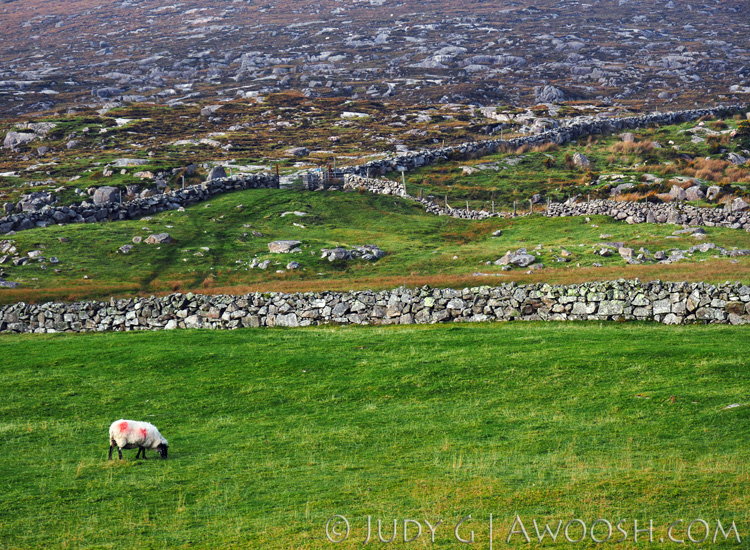
Woolly sheep in a rocky pasture, Connemara. Almost all the sheep we saw in Ireland (and we saw a lot) had painted markings like this one – apparently some sort of system of identification.
The drive down the coast, from Clifden, through Roundstone, and back to Galway, was gorgeous – small villages lining the roads, more woollies than people, and a calm day where the Pacific Ocean looked more like a millpond than the wild body of water that it can be on this open stretch of coast.
After we (again) survived the Galway ring road, and yet more roundabouts, we headed south, with the ambitious plan to arrive in Dingle town, on the Dingle Peninsula, before dark. As a way to shorten (and beautify) the route, we took Rick Steves’ advice and took a short ferry across the Shannon River Estuary, from Killimer in County Clare, to Tarbert in County Kerry. This route saves going ‘the long way around’ the Shannon Inlet and transiting through the big city of Limerick. By some freak of Irish luck, the ferry was late departing (it leaves on the hour from the north side, on the half hour from the south side) and we drove right on. High five!
On the Kerry side, it was a mad dash along country roads (which the Irish endearingly call secondary highways), slowing down through a couple of very pretty towns – Listowel and Tralee. 100 kph feels too fast for these narrow ribbons of roads, most especially as many homes have driveways that back onto them. After we made the turn at Tralee for the Dingle Peninsula, with the sun low and golden in the horizon, we got our first taste of Dingle’s epic scenery – mountains, gorgeous green fields, and sea. Up and over the mountains (again – who knew they had mountains as high as these in Ireland?), serpentine roads down the backside, and there we were, in the charming seaside town of Dingle, sliding in just as the last of the late afternoon light waned into darkness.
Dingle Town
I had done a quick search on Trip Advisor to find recommendations for places to stay in Dingle. Brenners hotel came up high on the list, the hotels.com price was right (note – much less than the rack rate on the hotel’s site), so we booked it. It was a great choice, and I would highly recommend. Make sure to get breakfast included in your reservation – it was the best we had while in Ireland. The nearest bars were but a mere half a block away, and there were at least five within one city block, so they all definitely fell into the “staggering distance” criteria ;^)
Again we did the pub crawl thing, starting at a place along the pretty street that runs along Dingle Harbour (picture above). Here we ate the fantastic fish and chips that I mentioned earlier. We then moved on to a couple of pubs closer to the hotel (An Droicead Beag and The Mighty Session), and stopped in at both for a pint. Both had live music starting at 9.30 – we went with the one that the receptionist at the hotel recommended, and weren’t disappointed. He was a super talented local singer songwriter named Michael. Apparently there is no shortage of seriously talented musicians in Ireland.
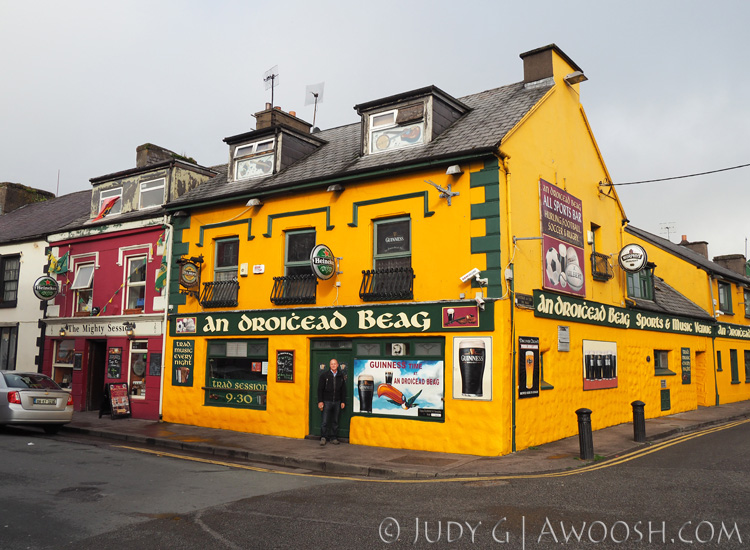
If I understood correctly, An Droicead Beag is Gaelic for something to do with a bridge. This large yellow building is actually part of a bridge that runs over a small creek in Dingle (as does the road).
Slea Head Drive
If you’ve seen the movie Ryan’s Daughter, you will recognize quite a bit of the scenery when you make this drive. However, in the movie, the villages look very impoverished and run down. These days, life in southern Ireland appears to be happily prosperous. Quite a bit of the movie was filmed at Slea Head, which is the westernmost tip of Europe. Next stop is Boston.
Rick Steves strongly recommended doing the Slea Head loop drive in a clockwise direction (leaving Dingle town), and we followed this advice. It was the right call – driving on the left side, this keeps you closest to the ocean, and makes it easier to pull out along the way to stop and take in the glorious views.
Like our morning waking up in Sandhill, the weather did not look good for our Dingle day. Heavy rain sluiced down the windows of our hotel. We lingered over the (excellent) breakfast, and hoped it would lighten up. As we headed out in the car, it did not look too promising in the drizzly rain, but then, amazingly, the sky started to brighten, the heavy shroud of clouds lifted a bit, and by the time we reached the south run of beautiful coastline, rays of sun started to poke through.
This next series of photos are set up in the order in which this scenery appeared. It did not suck…
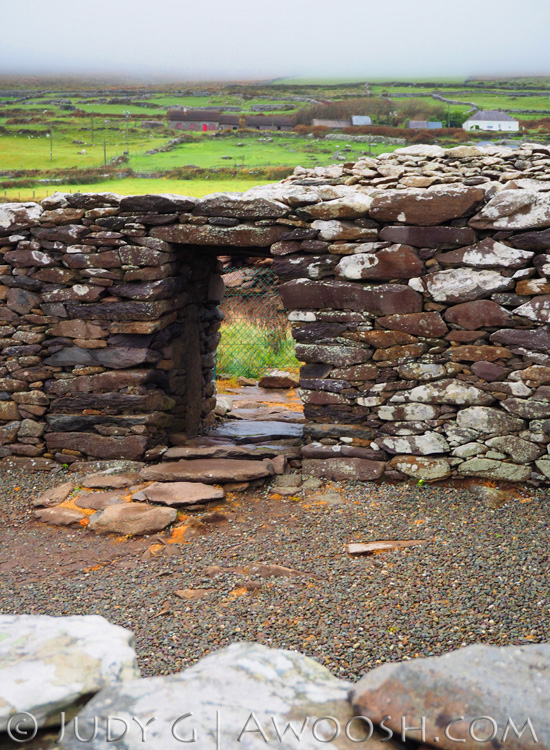
Dunbeg Fort – likely built between 500 BC and AD 500. It is part of a large compound, entirely built of stone, just above the raging ocean. It must have been a very harsh environment to live in.
And then there is Connor Pass on the Dingle Peninsula – a vertiginous, winding cut across the top of the mountains (versus the regular route most cars and trucks take). It was pretty socked in when we transited, but we got a few peekaboo views on the way down. On a clear day, this would have been spectacular…
After leaving Dingle Peninsula, we wound our way back up through Tralee, Listowel, across on the Shannon ferry, and north to the small city of Ennis, for our last night in Ireland.
Ennis is not a particularly touristy destination, but it was totally worth the visit. We stayed at the Temple Gate Hotel, which was a great location from which to head out on yet another pub crawl (and it has a very nice bar of its own). During our time in Ireland, Mr G had been in search of ‘Irish Stew’ – something his mom had made for him when he was a kid. We scoured menus everywhere we went, to no avail. So how happy was he to find it on the menu in the pub at the Temple Gate Hotel?
We totally lucked out and arrived on the first night of a four day music festival in Ennis, so all the pubs in the area had live music happening – several of them apparently ‘jam sessions’, where musicians just randomly showed up, started playing, and others joined in. After a while (and a few beers) the traditional Irish reels all start to sound quite similar (although we were assured there are variations on the theme ;^). We enjoyed watching the musicians introduce themselves to the group, and as a group, deciding what to play. Someone leads off, and then they all follow. When they play, it almost seems as if they are in a trance.
Our last wake up in Ireland – and we had a half day to explore Clare County, which features The Burren (a wild, glacier-scraped, rocky part of Ireland) and a spectacular coast, including the stunning Cliffs of Moher. Being that we were there in off-season, we saw nary a soul at these normally very touristy places. And, once again, the weather co-operated. It started out as a dull day, but the weather changes quickly on the west coast of Ireland, and by the time we drove the 45 minutes from Ennis to the Cliffs of Moher, the sun decided to make a (brief) appearance.
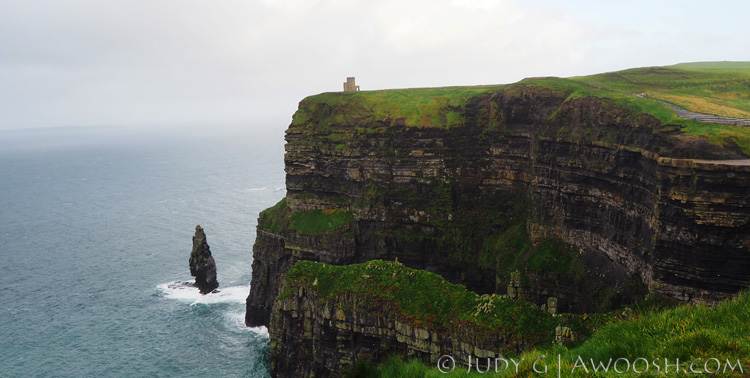
Cliffs of Moher, looking north from the ‘unsanctioned’ part of the cliffs – ie take your life in your own hands once you pass through a gate.
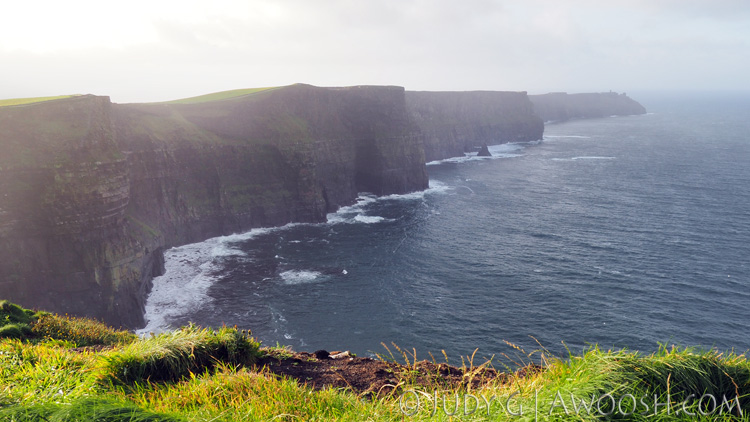
Cliffs of Moher, looking south from near O’Brien’s Tower. Spectacular topography, but tough to photograph on this day as the sky was very bright, but the cliffs were in shadow.

Apparently quite a few people have been blown over the ledge and fallen to their deaths at the Cliffs of Moher. It was very windy when we visited – swirly, treacherous currents of air. It looks like a lot of effort and expense was put into carving off chunks of slate, and making these safety barriers. The cliffs themselves are made of slate, and it looks as if these slabs were quarried locally.
Back in the car, we followed our planned route to scoot down the center of the Burren on our way back to Ennis, and Shannon Airport – to both see the barren landscape, and also to check out the Poulnabrone Dolmen – an ancient stone tomb that dates back at least 2500 BC. It’s pretty cool – hard to imagine Neolithic man quarrying and carting these huge slabs of stone.
You can’t drive around Ireland without seeing numerous ruins of old churches, castles and towers. Here are just a few that we saw along the way in County Clare:
Later that afternoon, we flew to London out of Shannon Airport on Aer Lingus. Shannon is a great little airport – so much saner than a big hub like Dublin. Flying in and out of there would be ideal, if visiting the west coast of Ireland.
From start to finish, we found the Irish people we met to be super friendly, helpful, and accommodating – even the Aer Lingus crew were keeners. The Irish are proud of their Gaelic heritage – with Dingle being the strongest bastion of language and tradition that we experienced – in some areas on the peninsula, the signs are only in Gaelic! Good to have your guidebook handy ;^). As I said before, I had the expectation that southern Ireland, after all the tumultuous history, would be a bit run down and impoverished. Man, was I wrong! Southern Ireland appears to be flourishing – and no doubt tourism is a prime contributor. It seems that there is a B&B on every block, city or country. Innumerable restaurants and pubs line the charming streets of towns and small cities.
Can’t wait to go back…

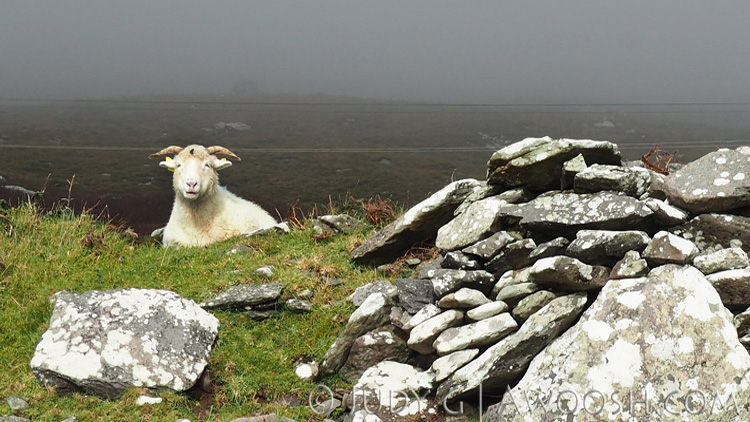
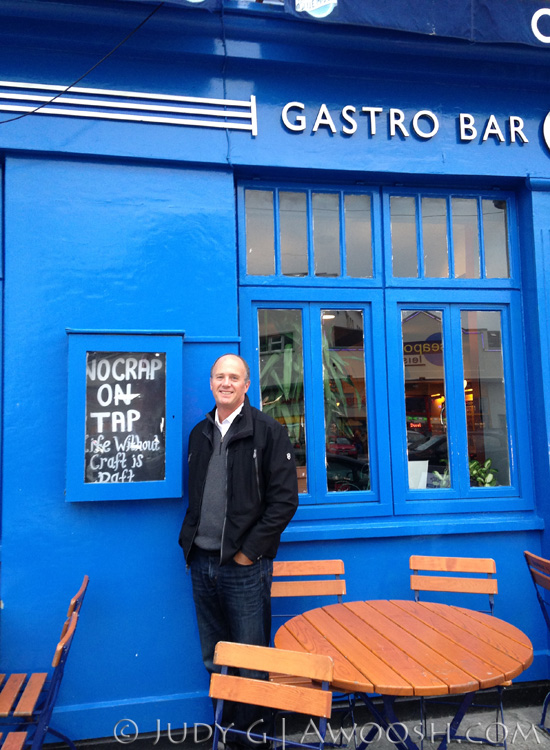





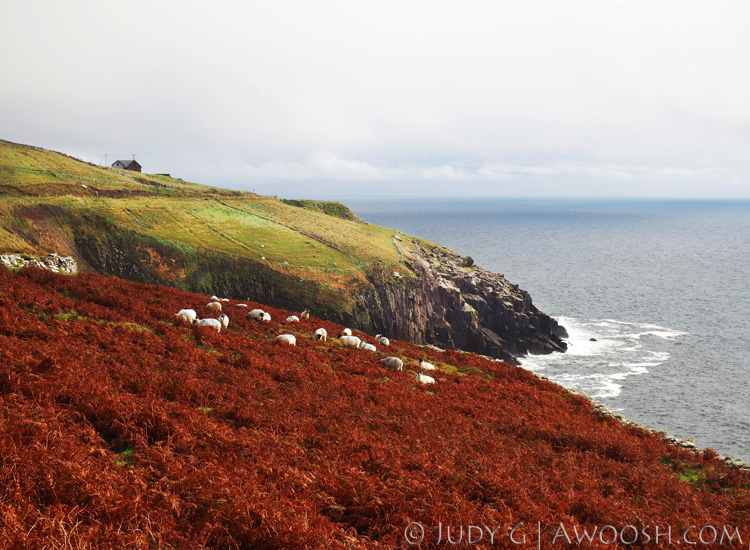
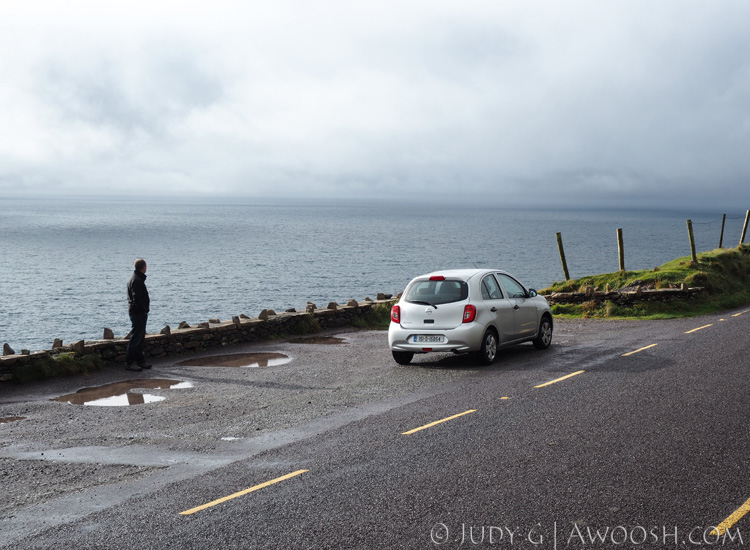

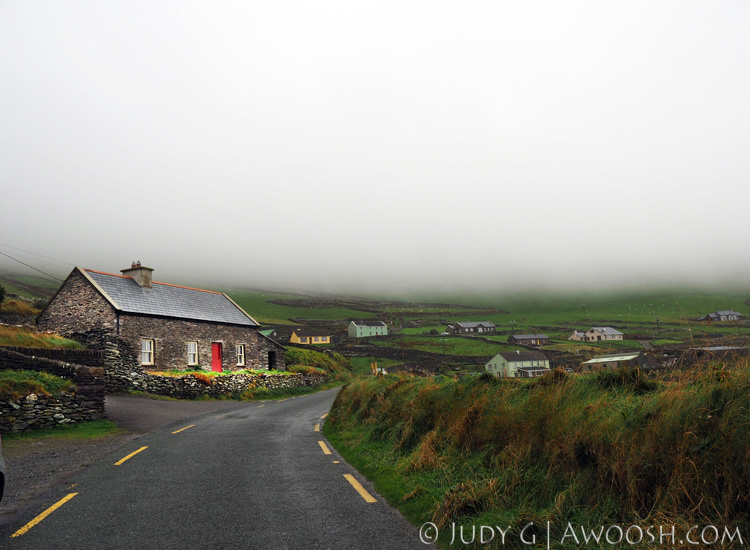
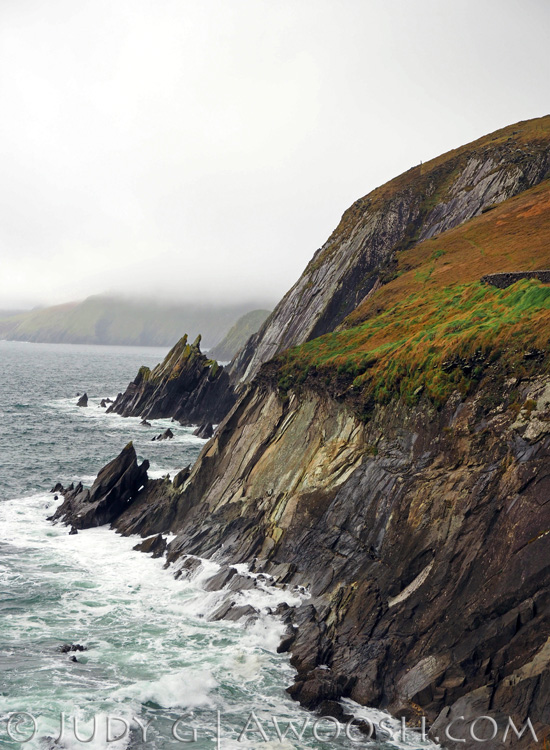
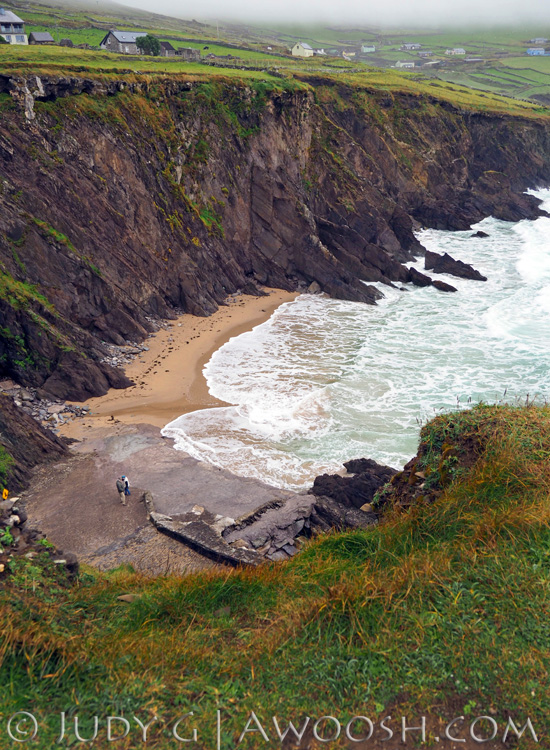

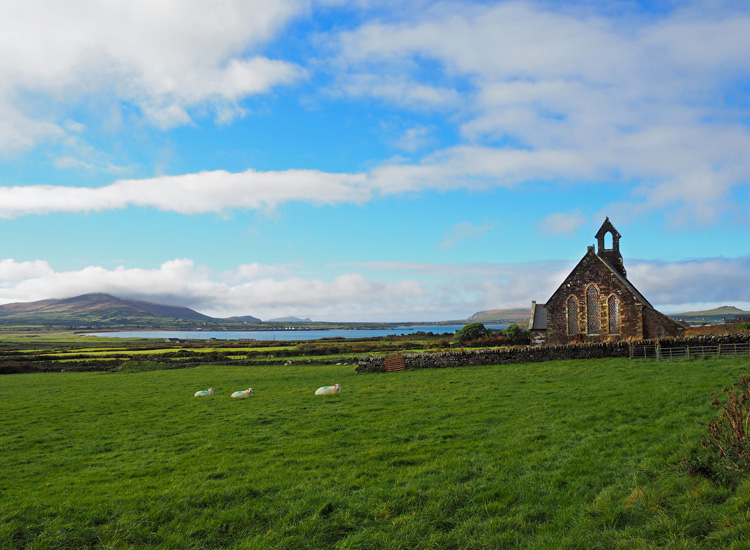
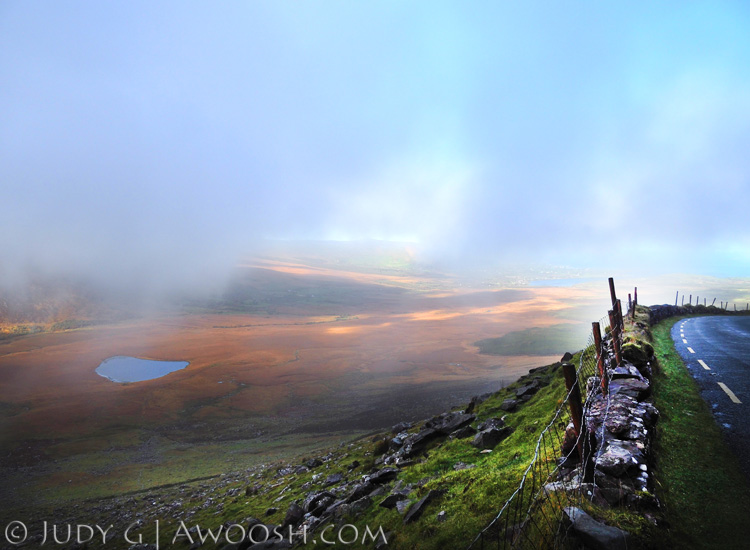

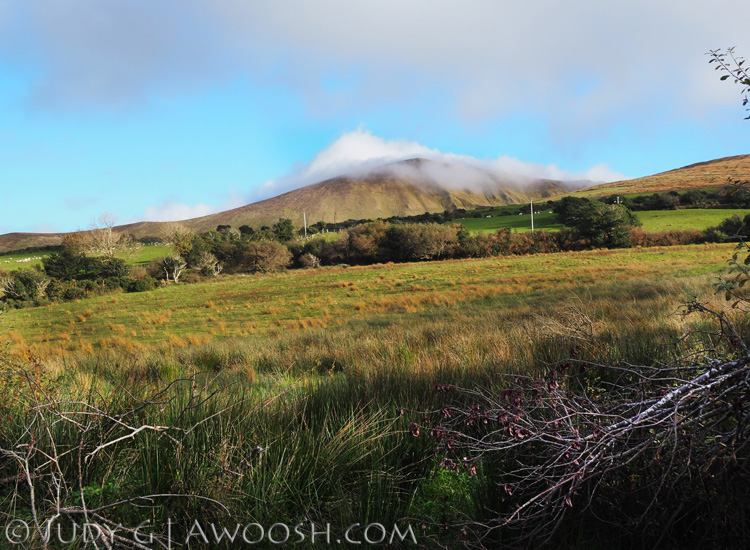
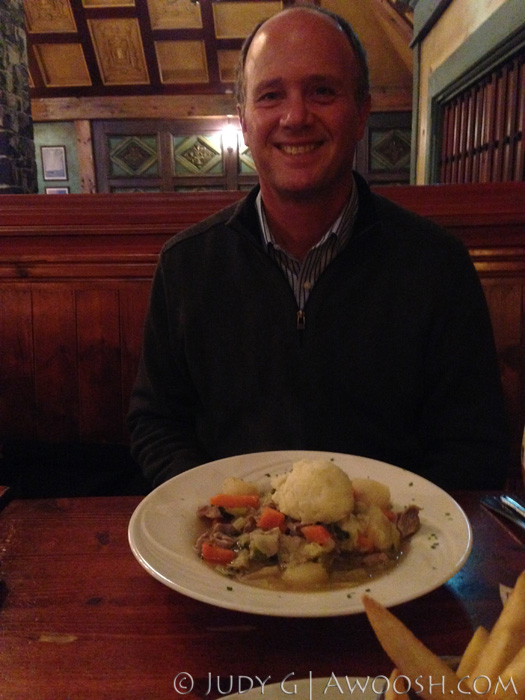
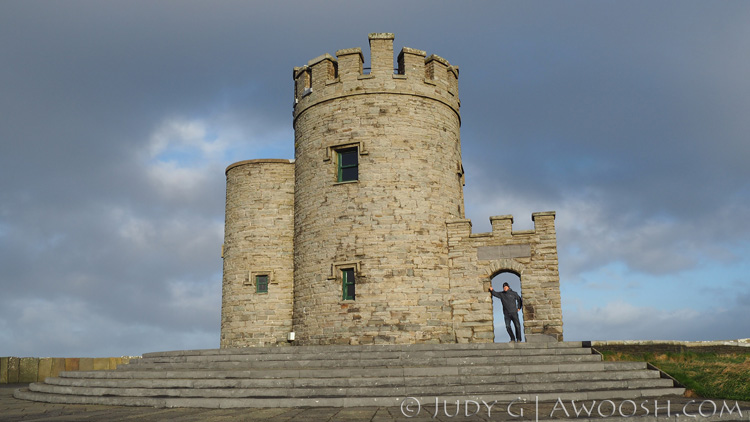
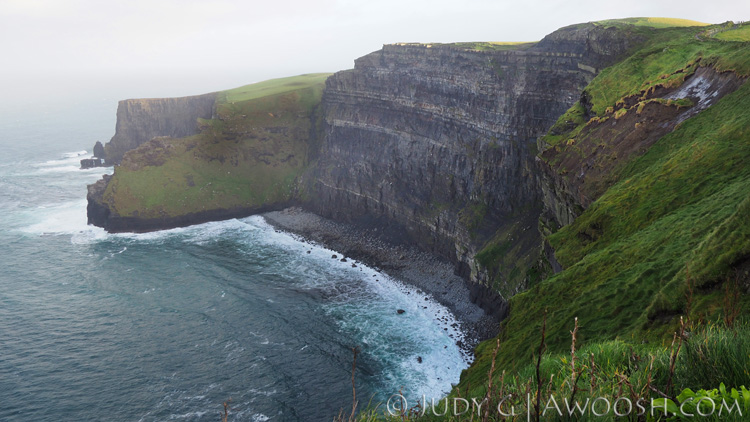

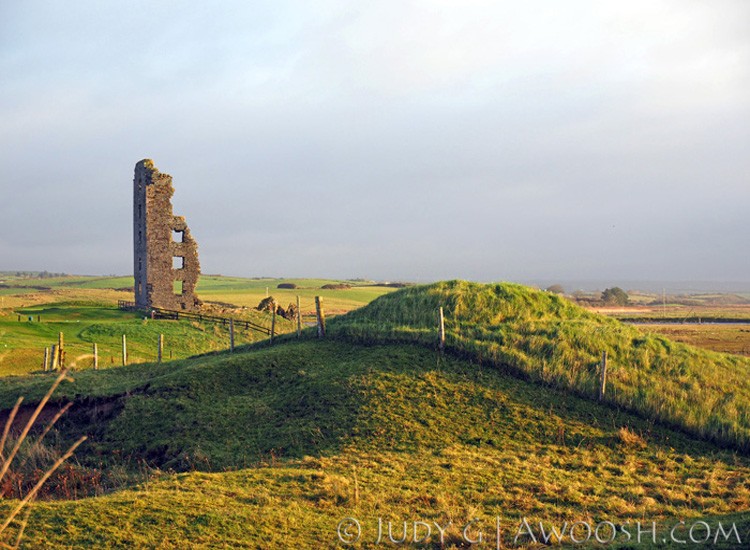
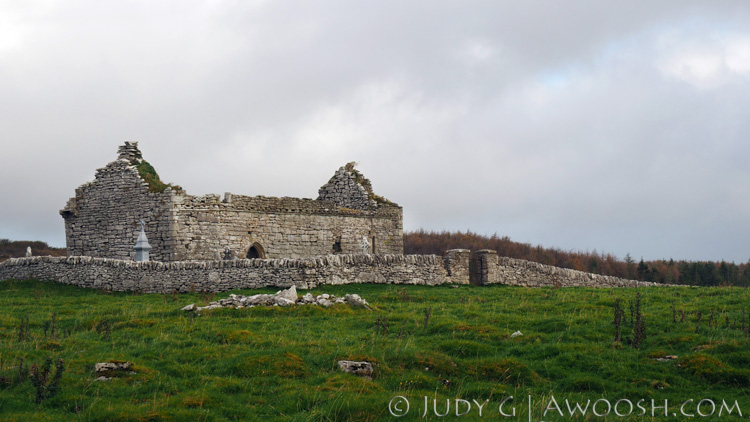
4 Responses to Wild & Woolly – An Irish Adventure